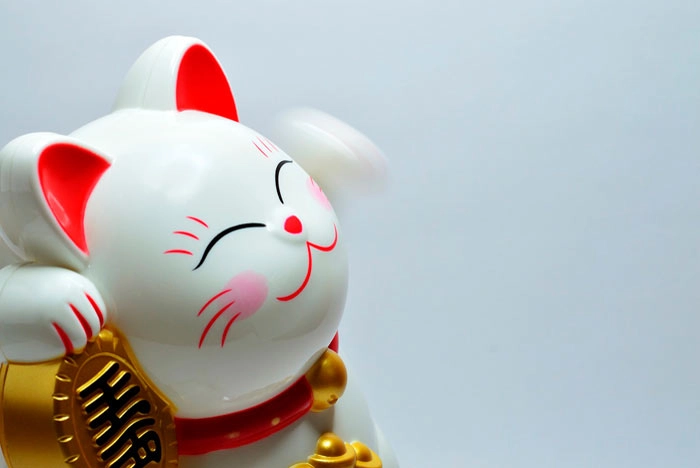This lucky cat, also known as “Maneki-neko“, is a very famous cat charm in Japanese and Chinese cultures. This “fortune cat” is said to bring good luck and wealth to its owner. Due to its meaning, it is common to see a figure of the Maneki cat displayed in supermarkets, restaurants, and other establishments.
Personally, apart from thinking that this cat was charming and knowing what it represented, after further researching its history, I realized that there were fascinating aspects that I still did not know about the little and mischievous Japanese lucky cat, Maneki.

Contents of this publication:
1. What does Maneki-neko mean?
In Japan, the lucky cat is known as Maneki-neko, which translates to “beckoning cat“. The cat’s paw is lifted as if it’s wishing its owners good luck. Other names for the lucky cat include: Money Cat, Waving Cat, and Welcoming Cat.
2. The myths and legends of Maneki-neko
The first story is about a wealthy guy who sought refuge from a downpour behind a tree near a temple. He spotted a cat that seemed to be inviting him into the shrine and followed it. Then lightning hit the tree he was standing behind shortly after.
The guy was so thankful to the cat for saving his life that he became a donor of the temple and brought it tremendous riches. A statue of the cat was erected in his honor after he died.
Another well-known folklore about Maneki-neko is a strange one. A geisha had a cat as a pet, which she cherished. It was tugging at her kimono one day, and the brothel owner assumed the cat was possessed, so he slashed the cat’s head off with a sword.
After that, the teeth of the flying cat head landed on a snake ready to attack, killing the snake and saving the woman. The geisha was so heartbroken at the loss of her cat that one of her clients created a statue of it to console her.
(Author’s note: Really disturbing story, I want to believe it’s not true.)

3. The importance of the paw that Maneki-neko has raised.
The paw raised by the Maneki lucky cat has a specific meaning. If it is the left paw, it means that you are looking to attract customers. On the other hand, when he raises his right paw it means that he seeks to bring luck and money.
In addition, sometimes you can see a Japanese lucky cat with both paws in the air, two raised legs signify a sign of protection.
4. The meanings of Maneki-neko colors

While you’re most likely to encounter a white Maneki-neko with orange and black dots, Maneki-neko comes in a variety of colors, each with its own meaning.
- Calico: is a traditional color combination that is said to bring good fortune.
- White: symbolizes joy, purity, and the promise of good things to come.
- Gold: symbolizes wealth and success.
- Black: Keeps bad spirits at bay.
- Red: denotes love and relationship success.
- Green: denotes good health.
5. The meaning of Maneki-neko’s clothes and holdings
A Maneki-neko is a well-dressed cat who wears a bib, collar, and bell. It was usual for affluent people to dress their pet cats in this manner during the Edo era, with a bell attached to the collar so that owners could keep track of their animals’ locations.

Maneki-neko – Japanese lucky cat
Fortune cat figurines are frequently seen with objects in their paws. These are some of them:
- A Koban valued in 1 (one) Ryo: This is an Edo-period Japanese currency; a Ryo was considered a significant sum of money at the time.
- A money mallet: If you see a tiny hammer, it means you have a lot of money. The mallet is said to attract prosperity when shaken.
- A fish (most likely a carp): The fish is a sign of prosperity and wealth.
- A marble or diamond: This is another money magnet, and some people think it signifies knowledge and that represents a crystal ball.
Lucky cats can be seen carrying gourds, prayer tablets, daikon radishes, and ingots. These objects are also associated with prosperity and good fortune.
In conclusion, you cannot go wrong by choosing to have a Maneki-neko by your side, regardless of what you call it, its legend, the paw it has raised, the color, or the object on its paw.
So now, a question for our readers: Do you have a Maneki-neko in your homes? If so, I encourage you to share a photo of yours in the comment box.
Until next post!.
Sayōnara (さようなら)
0 Comments